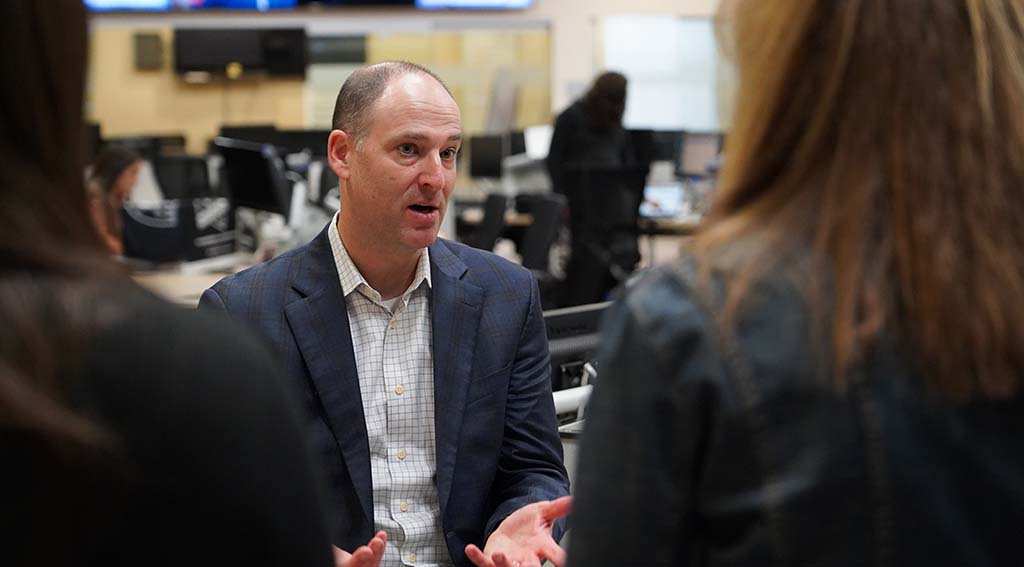Scripps CEO Defends Broadcast as Stocks Fall During Earnings Season
Sports streaming venture will pay station group’s ABC and Fox affiliates, Adam Symson says

Broadcast stocks got hammered last week, with the sports streaming venture formed by ESPN, Fox and Warner Bros. Discovery being the latest development to spook investors about the station business.
On earnings calls Friday, station-group heads tried to persuade Wall Street that despite the venture, eroding subscriber numbers and questions about the ad market, the sky wasn’t falling, and that local broadcast, in particular, was still a good bet.
Scripps stock dropped 19% after reporting a fourth-quarter loss, mainly due to special charges related to acquisitions and restructuring.
Also Read: Questions Surround Blockbuster Streaming Sports Venture
“I completely understand why even the most seasoned media investors are struggling to sort through the chaos,” E.W. Scripps Co. CEO Adam Symson said on his company’s call. "I've been a part of this business for a while … and it feels like the market is always ready to believe the worst about broadcast.”
From the standpoint of viewers, Symson said he sees the new streaming venture as cannibalizing other streaming products, rather than impacting broadcast.
Symson noted that the streaming venture — which does not involve CBS or NBC — will have only part of March Madness, half of the NFL game broadcasts and none of the Olympics.
Broadcasting & Cable Newsletter
The smarter way to stay on top of broadcasting and cable industry. Sign up below
“It's the introduction of yet another service into a fragmented landscape that will likely confuse and confound an already frustrated consumer,” he said. “This is not to say that the new offering won't get subscribers. If, as the partners say, it will target cord-cutters, we at Scripps will very much benefit from increased distribution fees and strength and reach.”
More importantly, the sports venture will be carrying the ABC and Fox broadcast networks, and Scripps and other broadcasters will receive retransmission-consent payments when subscribers sign up.
“[Network] executives have confirmed over and over that affiliates like Scripps will be carried along and compensated just as we are with the other virtual MVPDs,” Symson said.
“I can't see why analysts nor investors would see this as some sort of killer app,“ he said. ”But hey, if it adds new value to linear television, I'll be happy to root for its success and take advantage of its reach because we'll get paid for our ABC and Fox affiliates.”

Gray Television also reported earnings on Friday. Its stock also plunged 22%. Sinclair, Tegna and Nexstar shares were also down a few percentage points Friday.
“We think broadcast television is as healthy now, if not healthier than it’s been in decades,” Gray CEO Hilton Howell said.
“We actually did a video for our general managers back to the future. And because what we’re seeing is a return to broadcast television,“ Howell said. “Now I know that doesn’t fit the narrative out in New York, but too many people confuse the term linear television. A lot of people, what they mean by that, is cable-distributed cable networks.”
Benchmark analyst Daniel Kurnos, explained the market’s reaction to Gray’s results in a note Monday. “During a day where legacy media continued to fall out of favor, Gray added to the pressure by posting a solid end to 2024 and then offering one of the most baffling retrans guides in recent memory,“ Kurnos wrote.
“Somehow, with 56% of subs up for renewal this year, management suggested that gross retrans growth could be down year over year, effectively implying that subscriber losses were finally outweighing rate gains,” Kurnos said. “While there are several Gray-specific factors that likely go into that equation, the ramifications for the industry are profound if it ends up being closer to a blanket statement (early indicators lean more towards Gray-specific).”
Bullish About Local Ads, CTV
Executives with Scripps and Gray talked about the local ad market improving and new revenue being generated by connected TV (CTV) and other digital properties.
“One of the things that we have been so successful at is growing our digital revenue,” Howell said. “That’s 100% ours, and it gets bigger and bigger and bigger every year. And so I think there’s just a tremendous amount of opportunities for growth. And I think you’re going to see us have an extraordinary 2024.”
At Scripps, connected TV revenue was up 70% year-over-year and the company is expecting 45% growth in CTV revenue in the first quarter and more than 40% for 2024.
“We're benefiting from continued audience growth as Americans seek out new options for ad-supported free TV,” Scripps chief operating officer Lisa Knutson said.
Knutson said Scripps will be aggressive in the upfront. “Our partnership with the WNBA and the National Women's Soccer League are the foundation for recasting Ion into an entertainment destination for younger and more diverse audiences at scale, which is more attractive than ever to advertisers,” she said.
Sports are drawing new advertisers to Ion and other Scripps Networks across all time periods, she said.
“Sports advertising is serving as the tip of the spear for scatter-market advertising in general,” said Knutson. ’To that end, we are focused on growing our base of regular advertisers drawn by our sports programming and expanding into CTV and into our popular entertainment brands, with a specific focus on multicultural.”
Scripps also talked about Tablo, its broadcast digital video recorder.
Symson said Walmart started selling Tablo in January, but that Amazon accounts for about 60% of sales. HSN sold out in a few minutes when it launched Tablo in October.
Tablo could also fuel a data business at Scripps.
“Tablo is the only platform in the market that directly measures over-the-air viewing. Our back end measures all of the same data that set-top boxes do and more,” Symson said. “That valuable data and the monetization of the fast platform are the recurring revenue streams that drive value further downstream and will make up the average revenue per user metrics we’ll share with you in the future.”
Jon has been business editor of Broadcasting+Cable since 2010. He focuses on revenue-generating activities, including advertising and distribution, as well as executive intrigue and merger and acquisition activity. Just about any story is fair game, if a dollar sign can make its way into the article. Before B+C, Jon covered the industry for TVWeek, Cable World, Electronic Media, Advertising Age and The New York Post. A native New Yorker, Jon is hiding in plain sight in the suburbs of Chicago.

